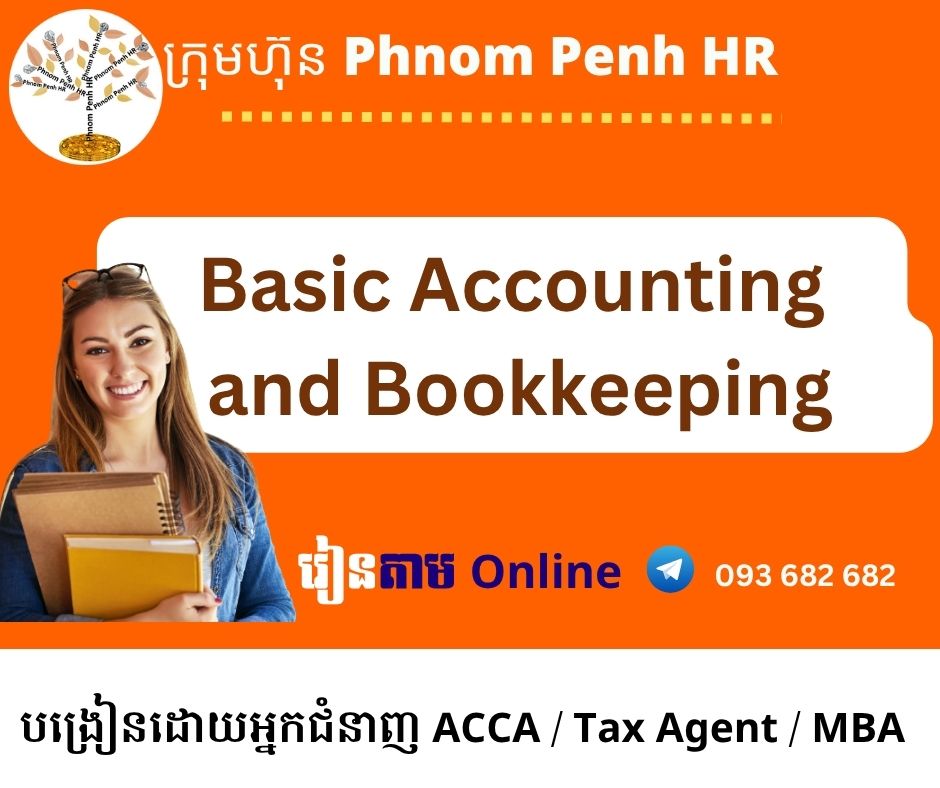រៀនផ្ទាល់តាម Online ៖ Basic Accounting and Bookkeeping (គណនេយ្យសម្រាប់អ្នកមិនទាន់ចេះចាប់ផ្តើមពីការកត់ត្រាដំបូងរហូតដល់បិទបញ្ជីគណនេយ្យ ) 👉 រៀនតែ ១ ថ្ងៃ វគ្គថ្មីចូលរៀនថ្ងៃព្រហស្បតិ៍ទី 21/8/2025 ពីម៉ោង 8 AM to 12 PM និង 1:30 PM to 5:30 PM
$120 Original price was: $120.$99Current price is: $99.
វគ្គនេះបណ្តុះបណ្តាលដោយផ្ទាល់ពី លោក យ៉ាន់ ណាង (Yan Nang) ជាអ្នកមានបទពិសោធន៍ការងារជាង ១៥ ឆ្នាំនិងបានបញ្ចប់ ACCA (អ្នកដែលអាចប្រលងជាប់ ៤ មុខវិជ្ជាក្នុងពេលតែម្តងលំដាប់ផុតលេខ), MBA/BBA (សិស្សពូកែ) ,Tax Agent (លំដាប់ពិន្ទុខ្ពស់)
ក្រុមហ៊ុន Phnom Penh HR នឹងធ្វើការបណ្តុះបណ្តាល គណនេយ្យសម្រាប់អ្នកមិនទាន់ចេះទាំង ទ្រឹស្តី និងការអនុវត្តជាក់ស្តែតាម Online ហើយសម្រាប់វគ្គនេះផ្តោតទៅលើ បងប្អូនដែលមិនចេះគណនេយ្យសោះ ឬ ចេះតិចតួច ក្រោយពីបញ្ចប់វគ្គនេះ គឺរំពឹង បងប្អូន អាចធ្វើជាគណនេយ្យករ ( Accountant )ក្រុមហ៊ុនបាន ៖
I. ខូបគណនេយ្យ (Accounting Cycle )
- ឯកសារគណនេយ្យ ( Accounting Documents )
- វិភាគប្រតិបត្តិការ ( Analyze transactions )
- ការកត់ត្រាក្នុងទិនានុប្បវត្តិទូទៅ (General Journal)
- ចំលងចូលសៀវភៅធំ (General Ledger/ GL)
- ចំលងចូលតារាងតុល្យភាព (Trial Balance / TB)
- ការកត់ត្រាកែតម្រូវ (Adjusting Entry)
- តារាងតុល្យភាពបន្ទាប់ពីការកត់ត្រាកែតម្រូវ (Adjusted Trial Balance)
- រៀបចំរបាយការណ៍ហិរញ្ញវត្ថុ( Preparing Financial Statements)
- ការកត់ត្រាបិទបញ្ជីគណនេយ្យ (Closing Entry)
- តារាងតុល្យភាពបន្ទាប់ពីបិទបញ្ជីគណនេយ្យ (After Closing Trial Balance )
II. Bank Reconciliation
Bank Reconciliation is a control mechanism that explains the difference between the bank balance shown in an organization’s accounting records and the balance shown on the bank statement.
Why It’s Important
-
Identifies errors in either the bank’s records or the company’s books.
-
Detects fraud or unauthorized transactions.
-
Ensures completeness of cash transactions.
-
Improves accuracy of financial statements.
III. Introduction to Inventory
Types of Inventory
-
Raw Materials – items used to produce finished goods.
-
Work-in-Progress (WIP) – goods that are in production but not yet finished.
-
Finished Goods – completed products ready for sale.
-
Merchandise Inventory – goods bought for resale (common in retail).
Cost includes:
-
Purchase price
-
Import duties and taxes (excluding recoverable ones)
-
Transport, handling, and other costs to bring inventory to its location and condition
Methods of Costing Inventory:
-
FIFO (First-In, First-Out)
-
Weighted Average Cost
IV. Introduction to tangible assets (Property, Plant and Equipment)
Property, Plant, and Equipment are tangible items that:
-
are held for use in the production or supply of goods or services, for rental to others, or for administrative purposes; and
-
are expected to be used during more than one period.
Key Features:
-
Physical Existence – Can be touched (e.g., machinery, land, buildings).
-
Used in Business Operations – Not held for resale (unlike inventory).
-
Long-term Nature – Expected to provide economic benefits for more than one accounting period.
-
Subject to Depreciation – Except for land, which is not depreciated.
Examples of Tangible Fixed Assets:
-
Land
-
Buildings
-
Machinery
-
Vehicles
-
Office equipment
-
Furniture and fixtures
Cost of tangible assets (Property, Plant and Equipment) including:
-
Purchase price
-
Import duties & taxes
-
Delivery & installation costs
-
Site preparation costs
-
Professional fees
Common Depreciation Methods
- Straight-Line
- Declining Balance
- Units of Production
- Sum-of-the-Years’-Digits
V. Prepare Basic Financial statements
$120 Original price was: $120.$99Current price is: $99.ចុច ចុះឈ្មោះរៀន
វគ្គសិក្សានិងសេវាកម្មផ្សេងទៀត
-
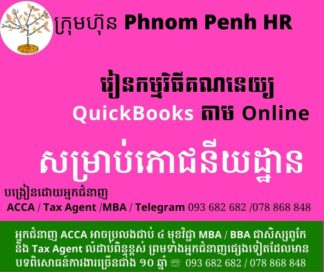
រៀនតាម Online របៀបកត់ត្រាគណនេយ្យសម្រាប់ភោជនីយដ្ឋានដោយប្រើកម្មវិធី QuickBooks រយៈពេល 4 ដង ( Accounting for Restaurant ) វគ្គថ្មីចូលរៀន នៅដើមខែក្រោយបន្ទាប់ពីចុះឈ្មោះ | សូមជ្រើសរើសថ្ងៃនិងម៉ោងចង់រៀននៅខាងក្រោម 👇 Select Options
$120 ចុច មើលព័ត៌មានលម្អិត -
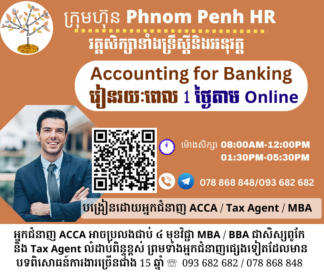
រៀនផ្ទាល់តាម Online ៖ Accounting for Banking (គណនេយ្យសម្រាប់វិស័យធនាគារ ) រៀនរយៈពេល 1 ថ្ងៃ ចូលរៀននៅសប្តាហ៍ក្រោយបន្ទាប់ពីចុះឈ្មោះ| សូមជ្រើសរើសថ្ងៃចង់រៀននៅខាងក្រោម 👇 Select Options
$120 ចុច មើលព័ត៌មានលម្អិត -
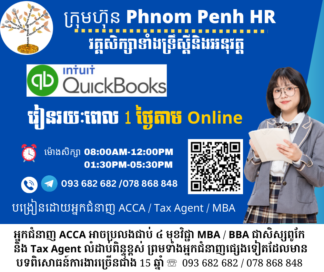
រៀនផ្ទាល់តាម Online ៖ ការកត់ត្រាបញ្ជីគណនេយ្យដោយប្រើកម្មវិធី QuickBooks រៀនរយៈពេល 1 ថ្ងៃ ចូលរៀននៅសប្តាហ៍ក្រោយបន្ទាប់ពីចុះឈ្មោះ| សូមជ្រើសរើសថ្ងៃចង់រៀននៅខាងក្រោម 👇 Select Options
$120 ចុច មើលព័ត៌មានលម្អិត -
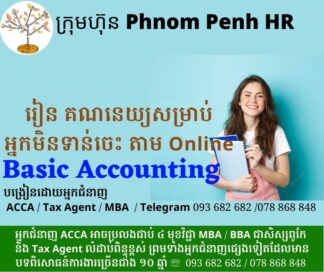
រៀនផ្ទាល់តាម Online ៖ Basic Accounting and Bookkeeping (គណនេយ្យសម្រាប់អ្នកមិនទាន់ចេះចាប់ផ្តើមពីការកត់ត្រាដំបូងរហូតដល់បិទបញ្ជីគណនេយ្យ ) រៀនរយៈពេល 4 ដង វគ្គថ្មីចូលរៀន នៅដើមខែក្រោយបន្ទាប់ពីចុះឈ្មោះ| សូមជ្រើសរើសថ្ងៃនិងម៉ោងចង់រៀននៅខាងក្រោម 👇 Select Options
$120 ចុច មើលព័ត៌មានលម្អិត -
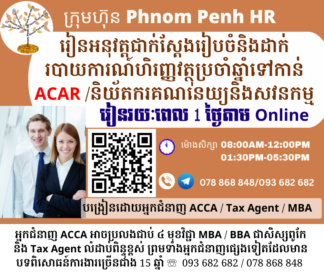
រៀនផ្ទាល់តាម Online ៖ ACAR / របៀបរៀបចំនិងដាក់របាយការណ៍ហិរញ្ញវត្ថុប្រចាំឆ្នាំទៅកាន់និយ័តករគណនេយ្យនិងសវនកម្ម ACAR ( Prepare and Submit Financial Statements to Accounting and Auditing Regulator ) | រៀនរយៈពេល 1 ថ្ងៃ វគ្គថ្មីចូលរៀននៅសប្តាហ៍ក្រោយបន្ទាប់ពីចុះឈ្មោះ| សូមជ្រើសរើសថ្ងៃនិងម៉ោងចង់រៀននៅខាងក្រោម 👇 Select Options
$190Original price was: $190.$130Current price is: $130. ចុច មើលព័ត៌មានលម្អិត -
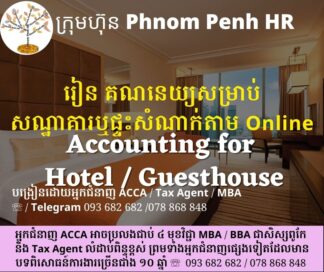
រៀន គណនេយ្យសម្រាប់សណ្ឋាគារឬផ្ទះសំណាក់ តាម Online រយៈពេល 4 ដង (Accounting for Hotel/ Guesthouse) វគ្គថ្មីចូលរៀន នៅដើមខែក្រោយបន្ទាប់ពីចុះឈ្មោះ| សូមជ្រើសរើសថ្ងៃនិងម៉ោងចង់រៀននៅខាងក្រោម 👇 Select Options
$120 ចុច មើលព័ត៌មានលម្អិត -
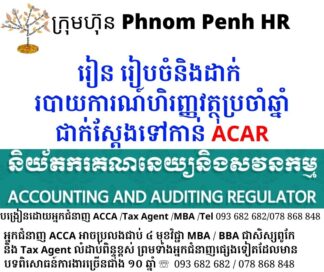
រៀនផ្ទាល់តាម Online ៖ រៀបចំនិងដាក់របាយការណ៍ហិរញ្ញវត្ថុប្រចាំឆ្នាំទៅកាន់និយ័តករគណនេយ្យនិងសវនកម្ម / ACAR (Study to Prepare and Submit Financial Statements to Accounting and Auditing Regulator ) រៀនរយៈពេល 4 ដង | វគ្គថ្មីចូលរៀននៅដើមខែក្រោយបន្ទាប់ពីចុះឈ្មោះ| សូមជ្រើសរើសថ្ងៃនិងម៉ោងចង់រៀននៅខាងក្រោម 👇 Select Options
$170Original price was: $170.$130Current price is: $130. ចុច មើលព័ត៌មានលម្អិត -
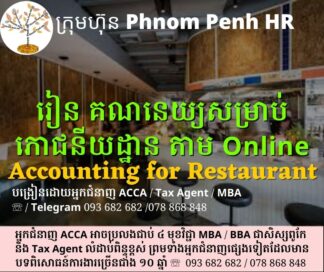
រៀន គណនេយ្យសម្រាប់ភោជនីយដ្ឋាន តាម Online រយៈពេល 4 ដង (Accounting for Restaurant) វគ្គថ្មីចូលរៀន នៅដើមខែក្រោយបន្ទាប់ពីចុះឈ្មោះ| សូមជ្រើសរើសថ្ងៃនិងម៉ោងចង់រៀននៅខាងក្រោម 👇 Select Options
$120 ចុច មើលព័ត៌មានលម្អិត -
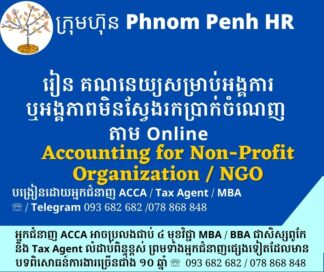
រៀន គណនេយ្យសម្រាប់អង្គការឬអង្គភាពមិនស្វែងរកប្រាក់ចំណេញ តាម Online រយៈពេល 4 ដង (Accounting for Non-Profit Organization / NGO) វគ្គថ្មីចូលរៀន នៅដើមខែក្រោយបន្ទាប់ពីចុះឈ្មោះ| សូមជ្រើសរើសថ្ងៃនិងម៉ោងចង់រៀននៅខាងក្រោម 👇 Select Options
$120 ចុច មើលព័ត៌មានលម្អិត -
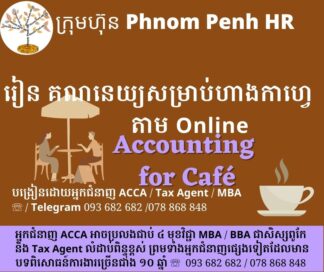
រៀន គណនេយ្យសម្រាប់ហាងកាហ្វេ តាម Online រយៈពេល 4 ដង (Accounting for Café) វគ្គថ្មីចូលរៀន នៅដើមខែក្រោយបន្ទាប់ពីចុះឈ្មោះ| សូមជ្រើសរើសថ្ងៃនិងម៉ោងចង់រៀននៅខាងក្រោម 👇 Select Options
$120 ចុច មើលព័ត៌មានលម្អិត -
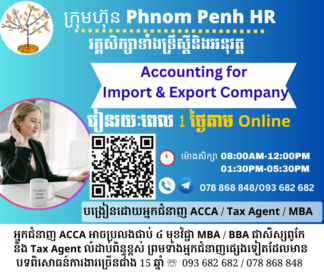
រៀនផ្ទាល់តាម Online ៖ Accounting for Import & Export Company ( គណនេយ្យសម្រាប់ក្រុមហ៊ុននាំចេញនាំចូល) រៀនរយៈពេល 1 ថ្ងៃ ចូលរៀននៅសប្តាហ៍ក្រោយបន្ទាប់ពីចុះឈ្មោះ| សូមជ្រើសរើសថ្ងៃចង់រៀននៅខាងក្រោម 👇 Select Options
$120 ចុច មើលព័ត៌មានលម្អិត -
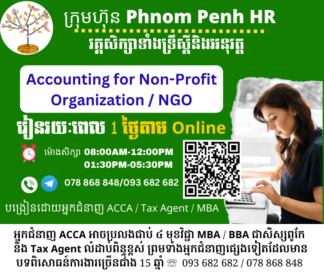
រៀនផ្ទាល់តាម Online ៖ Accounting for Non-Profit Organization / NGO (គណនេយ្យសម្រាប់អង្គការឬអង្គភាពមិនស្វែងរកប្រាក់ចំណេញ ) រៀនរយៈពេល 1 ថ្ងៃ ចូលរៀននៅសប្តាហ៍ក្រោយបន្ទាប់ពីចុះឈ្មោះ| សូមជ្រើសរើសថ្ងៃចង់រៀននៅខាងក្រោម 👇 Select Options
$120 ចុច មើលព័ត៌មានលម្អិត -
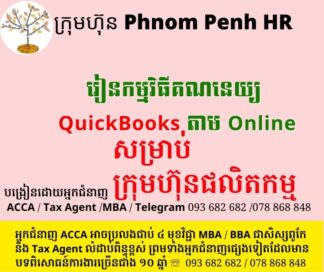
រៀនតាម Online របៀបកត់ត្រាគណនេយ្យសម្រាប់ក្រុមហ៊ុនផលិតកម្មដោយប្រើកម្មវិធី QuickBooks រយៈពេល 4 ដង ( Accounting for Manufacturing Company) វគ្គថ្មីចូលរៀន នៅដើមខែក្រោយបន្ទាប់ពីចុះឈ្មោះ| សូមជ្រើសរើសថ្ងៃនិងម៉ោងចង់រៀននៅខាងក្រោម 👇 Select Options
$120 ចុច មើលព័ត៌មានលម្អិត -

រៀនផ្ទាល់តាម Online ៖ មុខវិជ្ជា Costing, Stock Management and Analysis (គណនាថ្លៃដើម ការគ្រប់គ្រងស្តុក និងការវិភាគ ) រៀនរយៈពេល 1 ថ្ងៃ ចូលរៀននៅសប្តាហ៍ក្រោយបន្ទាប់ពីចុះឈ្មោះ| សូមជ្រើសរើសថ្ងៃចង់រៀននៅខាងក្រោម 👇 Select Options
$119 ចុច មើលព័ត៌មានលម្អិត -
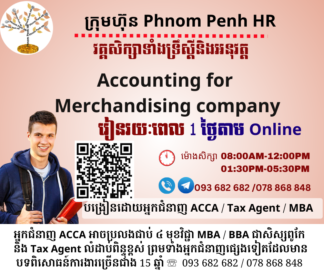
រៀនផ្ទាល់តាម Online ៖ Accounting for Merchandising company (គណនេយ្យសម្រាប់ក្រុមហ៊ុនទិញលក់ទំនិញ ) រៀនរយៈពេល 1 ថ្ងៃ ចូលរៀននៅសប្តាហ៍ក្រោយបន្ទាប់ពីចុះឈ្មោះ| សូមជ្រើសរើសថ្ងៃចង់រៀននៅខាងក្រោម 👇 Select Options
$120 ចុច មើលព័ត៌មានលម្អិត -
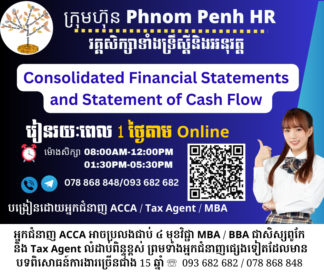
រៀនផ្ទាល់តាម Online ៖ ការរៀបចំរបាយការណ៍ហិរញ្ញវត្ថុរួមនិងរបាយការណ៍លំហូរសាច់ប្រាក់ ( Consolidated Financial Statements and Statement of Cash Flow) រៀនរយៈពេល 1 ថ្ងៃ ចូលរៀននៅសប្តាហ៍ក្រោយបន្ទាប់ពីចុះឈ្មោះ| សូមជ្រើសរើសថ្ងៃចង់រៀននៅខាងក្រោម 👇 Select Options
$120 ចុច មើលព័ត៌មានលម្អិត -

រៀនផ្ទាល់តាម Online ៖ Basic Accounting and Bookkeeping (គណនេយ្យសម្រាប់អ្នកមិនទាន់ចេះចាប់ផ្តើមពីការកត់ត្រាដំបូងរហូតដល់បិទបញ្ជីគណនេយ្យ ) រៀនរយៈពេល 1 ថ្ងៃ ចូលរៀននៅសប្តាហ៍ក្រោយបន្ទាប់ពីចុះឈ្មោះ| សូមជ្រើសរើសថ្ងៃចង់រៀននៅខាងក្រោម 👇 Select Options
$120 ចុច មើលព័ត៌មានលម្អិត -
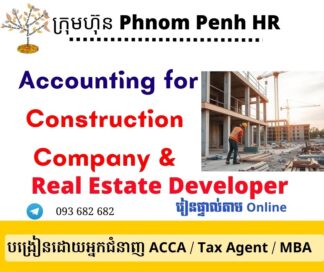
រៀនផ្ទាល់តាម Online ៖ Construction Accounting & Real Estate Developer (គណនេយ្យសម្រាប់ក្រុមហ៊ុនសាងសង់ ) 👉 រៀនតែ ១ ថ្ងៃ វគ្គថ្មីចូលរៀនថ្ងៃសុក្រទី 10/10/2025 ពីម៉ោង 8 AM to 12 PM និង 1:30 PM to 5:30 PM
$119Original price was: $119.$99Current price is: $99. ចុច ចុះឈ្មោះរៀន -
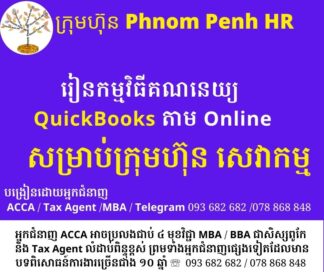
រៀនតាម Online របៀបកត់ត្រាគណនេយ្យសម្រាប់ក្រុមហ៊ុនសេវាកម្មដោយប្រើកម្មវិធី QuickBooks រយៈពេល 4 ដង ( Accounting for Service Company) វគ្គថ្មីចូលរៀន នៅដើមខែក្រោយបន្ទាប់ពីចុះឈ្មោះ| សូមជ្រើសរើសថ្ងៃនិងម៉ោងចង់រៀននៅខាងក្រោម 👇 Select Options
$120 ចុច មើលព័ត៌មានលម្អិត -
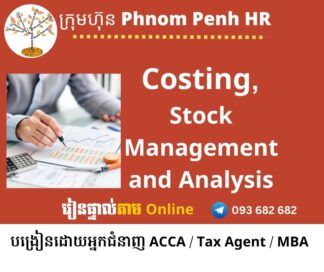
រៀនផ្ទាល់តាម Online ៖ Costing, Stock Management and Analysis (គណនាថ្លៃដើម ការគ្រប់គ្រងស្តុក និងការវិភាគ ) 👉រៀនតែ ១ ថ្ងៃ វគ្គថ្មីចូលរៀនថ្ងៃចន្ទ័ទី 25/8/2025 ពីម៉ោង 8 AM to 12 PM និង 1:30 PM to 5:30 PM
$119Original price was: $119.$99Current price is: $99. ចុច ចុះឈ្មោះរៀន -
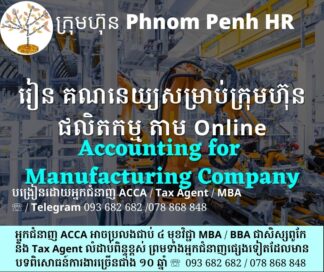
រៀនផ្ទាល់តាម Online ៖ Accounting for Manufacturing Company (គណនេយ្យសម្រាប់ក្រុមហ៊ុនផលិតកម្ម) វគ្គថ្មីចូលរៀននៅដើមខែក្រោយបន្ទាប់ពីចុះឈ្មោះ ហើយរៀនចំនួន 4 ដង| សូមជ្រើសរើសថ្ងៃនិងម៉ោងចង់រៀននៅខាងក្រោម 👇 Select Options
$120 ចុច មើលព័ត៌មានលម្អិត -
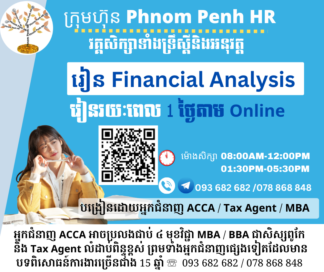
រៀនផ្ទាល់តាម Online ៖ មុខវិជ្ជា Financial Analysis (វិភាគរបាយការណ៍ហិរញ្ញវត្ថុ ) រៀនរយៈពេល 1 ថ្ងៃ ចូលរៀននៅសប្តាហ៍ក្រោយបន្ទាប់ពីចុះឈ្មោះ| សូមជ្រើសរើសថ្ងៃចង់រៀននៅខាងក្រោម 👇 Select Options
$120 ចុច មើលព័ត៌មានលម្អិត -
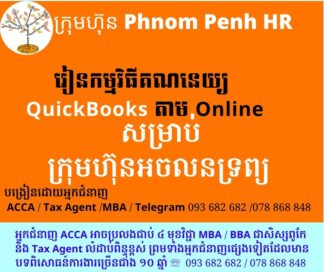
រៀនតាម Online របៀបកត់ត្រាគណនេយ្យសម្រាប់ក្រុមហ៊ុនអចលនទ្រព្យដោយប្រើកម្មវិធី QuickBooks រយៈពេល 4 ដង ( Accounting for Real Estate Company) វគ្គថ្មីចូលរៀន នៅដើមខែក្រោយបន្ទាប់ពីចុះឈ្មោះ| សូមជ្រើសរើសថ្ងៃនិងម៉ោងចង់រៀននៅខាងក្រោម 👇 Select Options
$120 ចុច មើលព័ត៌មានលម្អិត -
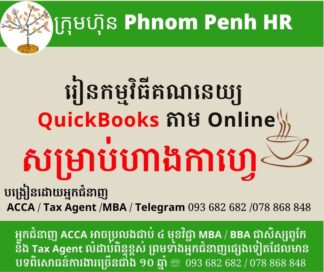
រៀនតាម Online របៀបកត់ត្រាគណនេយ្យសម្រាប់ហាងកាហ្វេដោយប្រើកម្មវិធី QuickBooks រយៈពេល 4 ដង ( Accounting for Café) វគ្គថ្មីចូលរៀន នៅដើមខែក្រោយបន្ទាប់ពីចុះឈ្មោះ | ចង់រៀនពេលណា ? ជ្រើសរើសពេលខាងក្រោម 👇 Select Options
$120 ចុច មើលព័ត៌មានលម្អិត -
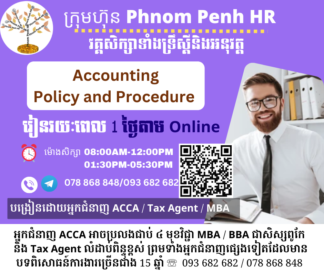
រៀនផ្ទាល់តាម Online ៖ Fundamental Accounting Standard for SMEs , Accounting Policy & Procedure (ស្តង់ដារគណនេយ្យមូលដ្ឋានសម្រាប់សហគ្រាសធុនតូចនិងមធ្យម រួមទាំង គោលនយោបាយគណនេយ្យ និង នីតិវិធី ) រៀនរយៈពេល 1 ថ្ងៃ ចូលរៀននៅសប្តាហ៍ក្រោយបន្ទាប់ពីចុះឈ្មោះ| សូមជ្រើសរើសថ្ងៃចង់រៀននៅខាងក្រោម 👇 Select Options
$120 ចុច មើលព័ត៌មានលម្អិត -
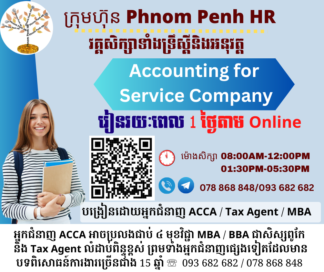
រៀនផ្ទាល់តាម Online ៖ Accounting for Service Company (គណនេយ្យសម្រាប់ក្រុមហ៊ុនសេវាកម្ម ) រៀនរយៈពេល 1 ថ្ងៃ ចូលរៀននៅសប្តាហ៍ក្រោយបន្ទាប់ពីចុះឈ្មោះ| សូមជ្រើសរើសថ្ងៃចង់រៀននៅខាងក្រោម 👇 Select Options
$120 ចុច មើលព័ត៌មានលម្អិត -
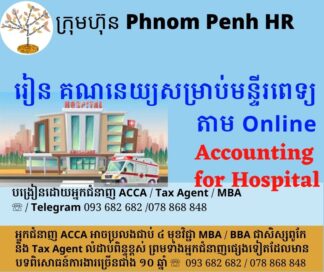
រៀន គណនេយ្យសម្រាប់មន្ទីរពេទ្យ តាម Online រយៈពេល 4 ដង (Accounting for Hospital ) វគ្គថ្មីចូលរៀន នៅដើមខែក្រោយបន្ទាប់ពីចុះឈ្មោះ| សូមជ្រើសរើសថ្ងៃនិងម៉ោងចង់រៀននៅខាងក្រោម 👇 Select Options
$120 ចុច មើលព័ត៌មានលម្អិត -
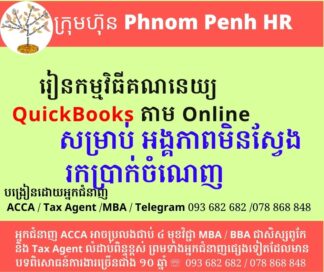
រៀនតាម Online របៀបកត់ត្រាគណនេយ្យសម្រាប់អង្គការមិនស្វែងរកប្រាក់ចំណេញដោយប្រើកម្មវិធី QuickBooks រយៈពេល 4 ដង ( Accounting for non-profit organization/NGO ) វគ្គថ្មីចូលរៀន នៅដើមខែក្រោយបន្ទាប់ពីចុះឈ្មោះ| សូមជ្រើសរើសថ្ងៃនិងម៉ោងចង់រៀននៅខាងក្រោម 👇 Select Options
$120 ចុច មើលព័ត៌មានលម្អិត -
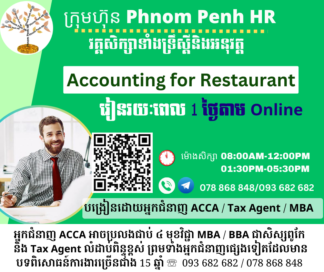
រៀនផ្ទាល់តាម Online ៖ Accounting for Restaurant (គណនេយ្យសម្រាប់ភោជនីយដ្ឋាន) រៀនរយៈពេល 1 ថ្ងៃ ចូលរៀននៅសប្តាហ៍ក្រោយបន្ទាប់ពីចុះឈ្មោះ| សូមជ្រើសរើសថ្ងៃចង់រៀននៅខាងក្រោម 👇 Select Options
$120 ចុច មើលព័ត៌មានលម្អិត -
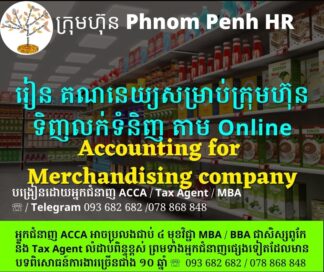
រៀនផ្ទាល់តាម Online ៖ Accounting for Merchandising company (គណនេយ្យសម្រាប់ក្រុមហ៊ុនទិញលក់ទំនិញ ) រៀនរយៈពេល 4 ដង វគ្គថ្មីចូលរៀន នៅដើមខែក្រោយបន្ទាប់ពីចុះឈ្មោះ| សូមជ្រើសរើសថ្ងៃនិងម៉ោងចង់រៀននៅខាងក្រោម 👇 Select Options
$120 ចុច មើលព័ត៌មានលម្អិត -
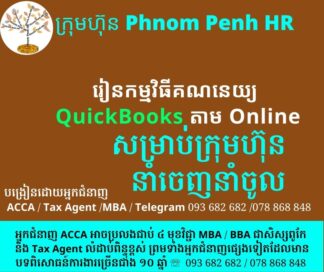
រៀនតាម Online របៀបកត់ត្រាគណនេយ្យសម្រាប់ក្រុមហ៊ុននាំចេញនាំចូលដោយប្រើកម្មវិធី QuickBooks រយៈពេល 4 ដង ( Accounting for Import and Export Company) វគ្គថ្មីចូលរៀន នៅដើមខែក្រោយបន្ទាប់ពីចុះឈ្មោះ| សូមជ្រើសរើសថ្ងៃនិងម៉ោងចង់រៀននៅខាងក្រោម 👇 Select Options
$120 ចុច មើលព័ត៌មានលម្អិត -
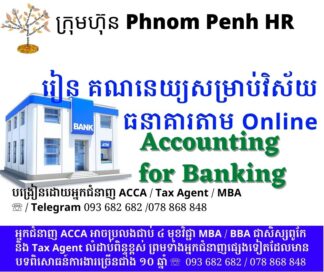
រៀន គណនេយ្យសម្រាប់វិស័យធនាគារ តាម Online រយៈពេល 4 ដង (Accounting for Banking) វគ្គថ្មីចូលរៀន នៅដើមខែក្រោយបន្ទាប់ពីចុះឈ្មោះ| សូមជ្រើសរើសថ្ងៃនិងម៉ោងចង់រៀននៅខាងក្រោម 👇 Select Options
$120 ចុច មើលព័ត៌មានលម្អិត -
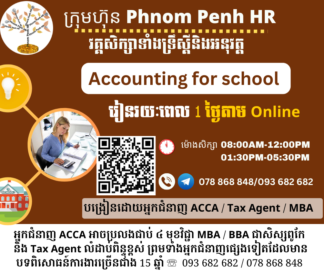
រៀនផ្ទាល់តាម Online ៖ Accounting for school ( គណនេយ្យសម្រាប់សាលារៀន ) រៀនរយៈពេល 1 ថ្ងៃ ចូលរៀននៅសប្តាហ៍ក្រោយបន្ទាប់ពីចុះឈ្មោះ| សូមជ្រើសរើសថ្ងៃចង់រៀននៅខាងក្រោម 👇 Select Options
$120 ចុច មើលព័ត៌មានលម្អិត -
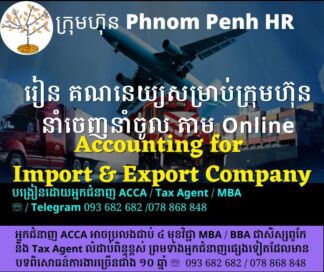
រៀនផ្ទាល់តាម Online ៖ Accounting for Import & Export Company (គណនេយ្យសម្រាប់ក្រុមហ៊ុននាំចេញនាំចូល) រៀនរយៈពេល 4 ដង វគ្គថ្មីចូលរៀន នៅដើមខែក្រោយបន្ទាប់ពីចុះឈ្មោះ| សូមជ្រើសរើសថ្ងៃនិងម៉ោងចង់រៀននៅខាងក្រោម 👇 Select Options
$120 ចុច មើលព័ត៌មានលម្អិត -
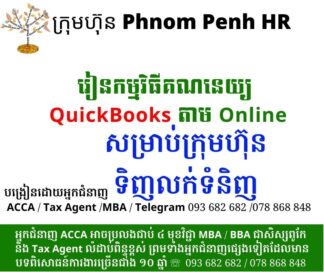
រៀនតាម Online របៀបកត់ត្រាគណនេយ្យសម្រាប់ក្រុមហ៊ុនទិញលក់ទំនិញដោយប្រើកម្មវិធី QuickBooks រយៈពេល 4 ដង ( Accounting for Merchandising Company) វគ្គថ្មីចូលរៀន នៅដើមខែក្រោយបន្ទាប់ពីចុះឈ្មោះ| សូមជ្រើសរើសថ្ងៃនិងម៉ោងចង់រៀននៅខាងក្រោម 👇 Select Options
$120 ចុច មើលព័ត៌មានលម្អិត -
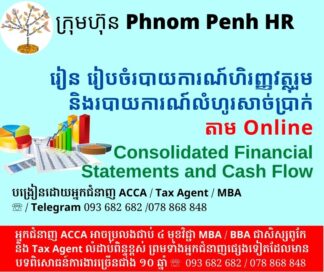
រៀនផ្ទាល់តាម Online ៖ Consolidated Financial Statements and Statement of Cash Flow (រៀបចំរបាយការណ៍ហិរញ្ញវត្ថុរួមនិងរបាយការណ៍លំហូរសាច់ប្រាក់) រៀនរយៈពេល 4 ដង វគ្គថ្មីចូលរៀន នៅដើមខែក្រោយបន្ទាប់ពីចុះឈ្មោះ| សូមជ្រើសរើសថ្ងៃនិងម៉ោងចង់រៀននៅខាងក្រោម 👇 Select Options
$120 ចុច មើលព័ត៌មានលម្អិត
